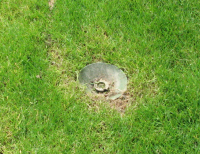This is a guest post from Hester Mazzola, Texas tough and proudly American. Thanks for contributing Hester!
SMART controllers are loosely defined as any controller that can make changes to its programming based on information from outside sources, such as weather stations or paid weather services. This does not include simple rain or freeze sensors.
The idea behind SMART controllers is simple. The owner will program the controller with the required information, usually including landscaping and the location, usually by zip code. This gives the controller a base line of effectiveness. From that point on the controller will review information obtained from the local weather station or provider and add or subtract watering times. When it works this can save money on water and help provide improved growing conditions for your soil.
We’ll discuss SMART controllers, their design and application, efficiency and, finally, if they are worth your investment. We’ll begin with one that is considered a SMART controller and is “the first controller from a full‑line irrigation manufacturer to earn the Environmental Protection Agency (EPA) WaterSense label.”, as noted on their site. It is an exception to the general definition.
The Rain Bird ESP-SMT is considered a SMART controller yet does not get data from a weather station. Instead it relies on historical data, information on your soil and plants entered by you, and an onsite rain collection and measuring unit. It then modifies the program according to local rain amounts combined with historical data and trends.
While relatively accurate the ESP-EMT is famous for being difficult to program. Some consumers have said they spent up to an hour gathering information and inputting information. If the manual is read thoroughly and consideration given to the questions before programming starts then 20 to 30 minutes would be a realistic programming time. While this might seem excessive and tedious remember this is a one-time operation. The controller will do its own adjustments from then on.
Typical inputs required are your zip code and (from the manual):
• Enter Soil Type…………………………………………………………20
• Select Sprinkler Type Method………………………………….. .21
• Select Time-Based Method………………………………………..24
• Cycle/Soak……………………………………………………………….25
• Select Plant Type Method – Grass Lawns…………………….26
• Select Plant Type Method – Non-Grass Lawns……………..27
• Select Plant Water Needs – (Non-Grass Plant Types)…….27
• Custom Plant Factor Method……………………………………..28
• Enter Plant Density…………………………………………………..28
• Enter Shade Factor……………………………………………………29
• Enter Plant Maturity – (Established Method)………………..29
• Enter Plant Maturity – (Newly Planted Method)……………29
While the manual does give guideline charts, as shown, some of the data is an average of industry and may not match what you use. For example, it lists sprays as having an application rate of 1.60”/hour. Manufacturers’ specifications may differ. For example, the Rain Bird 12’ full circle nozzle, very common, applies 1.74”/hr; the Hunter equivalent = 1.80”/hr. The included charts would get you close but could cause under watering.
Once programmed the ESP-SMT is self sufficient. As with any SMART controller from any company you must monitor your plants for the first two to four weeks to ensure your original settings are correct.
Is it worth the money and time spent? All indications from users are yes; it does work and does save money by accurately controlling the water used. Most problems can be traced back to an error in the original programming. Correctly installed and programmed it appears to be an accurate, reliable SMART controller.
NEXT PAPER: Field testing of different SMART controllers.

